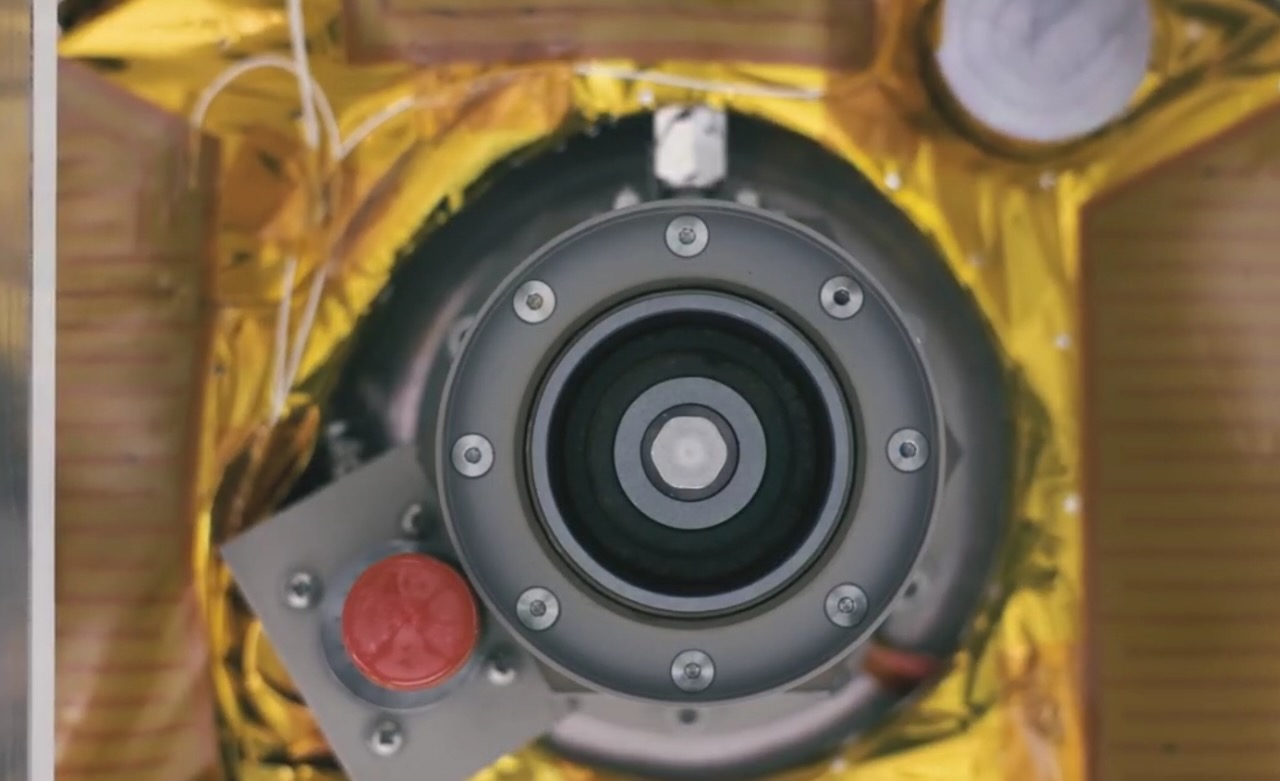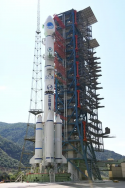You are using an out of date browser. It may not display this or other websites correctly.
You should upgrade or use an alternative browser.
You should upgrade or use an alternative browser.
China's Space Program Thread II
- Thread starter Blitzo
- Start date
by78
General
High-resolution images from the latest Long March 3B launch, which successfully inserted the 57th and 58th Beidou navigation satellites into orbit. They will serve as backup satellites to bolster the reliability of the constellation. The launch marked the 504th flight of the Long March series.










by78
General
HD video + high-resolution images of the third Zhuque-2 rocket launch, which successfully inserted Tianyi-33 (天仪33) and two Honghu (鸿鹄) satellites into orbit, all three being experimental satellites. This is the world's first commercial launch of a LOX/Methane rocket.

The Honghu satellites launched on December 9th featured Hall thrusters using krypton propellant. The thrusters were successful ignited at 6:49AM on December 26, Beijing Time, marking the first time that China has achieved on-orbit operation of Hall thrusters using Krypton propellant. The Hall thrusters (Model SW-200) were developed by Hongqing Technology (鸿擎科技).


And? China has done basically all of those besides land a person on the moon, something which US seemingly magically just lost the ability to do anyways in more than 50 years.SpaceX is just part of overall US technology. US has landed man on the moon, have rovers with helicopters on Mars, has James Webb space Telescope. They have visited all the planets in the solar system and gone past Solar System into Interstellar space. So, China is like 50 years behind in Space Achievements when you compare it with Space technology and Nasa. Its not even a competition at the moment.
Who is the only country that owns their own space station and is slated to have the only permanent space station in a few years after the ISS becomes too old to function?
SpaceX is the Xiaomi of space companies, rapidly expanding by going into low level niches that anyone can do, relying on being faster than others. The most expensive and difficult parts of SpaceX rockets, the engine, come from Russia. A country denounced by US themselves as a glorified gas station.China is simply retracing US footsteps and has a long way to go before it gets close to Nasa in terms of ticking boxes of Space Achievements.
But, the hype these days is what SpaceX is doing on Reusable Rocket technology and Heavy lift. There is a lot of hype about Starlink and how US can monopolize many country's internet access via starlink. So, what China doing in order not fall behind when it comes to these technologies. That is my question
Everything else is just fluff that can be rapidly developed, as shown by the many no-name Chinese private space actors, hoping to use ready-made tech from CNSA the same way SpaceX made big bucks from existing Russian and NASA tech.
China's national focus has been on the stuff that is extremely difficult to develop, such as orbital technology and rocket engines. Imho it should not be compared with SpaceX at all.
The focus on orbit is more useful in the event of conflict, and ultimately yields higher levels of space control, even if it's not as flashy as landing rovers.
Yeah....They are upgrading the booster to narrow the landing zone. I remember they said to test para-booster twice in 2023/24 & to replace all boosters of 3B/3C/2F to para-booster. Hope they could pull it off next year.Gotta say that littering the countryside with exploding hypergolic boosters seems to be a suboptimal solution:

Last edited:
by78
General
An that the Einstein probe will be launched in January of 2024 from Xichang.

Final preparations are underway for the launch next month.


Gotta say that littering the countryside with exploding hypergolic boosters seems to be a suboptimal solution:
Or just get rid of the aging hypergolic rocket fleet. This is just embarrassing and pathetic, how can China claim to be a 1st class modern space power when most of their rocket launches are still 40 year old hypergolic rocket designs? Forget about people arguing about China vs SpaceX in the last few pages, no other space agency in the world still uses hypergolics to such a large degree, not even ISRO. We don't even need to talk safety and cost factor but hypergolic rockets give vastly less performance too. This is why, despite China's number of launches almost doubling that of Russia, their payload to orbit doesn't have the same difference.Yeah....They are upgrading the booster to narrow the landing zone. I remember they said to test para-booster twice in 2023/24 & to replace all boosters of 3B/3C/2F to para-booster. Hope they could pull it off next year.

This is why number of launches don't matter nearly as much as payload to orbit. China's massive number of launches mask the fact that most of their launches are of tiny little small/medium lift rockets that can carry a tiny fraction of modern cryogenic rockets.
The more and more I see China refusing to phase out it's hypergolic rockets, the more I'm reminded of some state failed state that refuses to upgrade it's army, still using human wave tactics and WWII tanks and aircraft just so that they can boost of having millions of tanks and planes and comparing themselves to a much smaller modern day army and claiming that they are superior.
Or just get rid of the aging hypergolic rocket fleet. This is just embarrassing and pathetic, how can China claim to be a 1st class modern space power when most of their rocket launches are still 40 year old hypergolic rocket designs? Forget about people arguing about China vs SpaceX in the last few pages, no other space agency in the world still uses hypergolics to such a large degree, not even ISRO. We don't even need to talk safety and cost factor but hypergolic rockets give vastly less performance too. This is why, despite China's number of launches almost doubling that of Russia, their payload to orbit doesn't have the same difference.
View attachment 123073
This is why number of launches don't matter nearly as much as payload to orbit. China's massive number of launches mask the fact that most of their launches are of tiny little small/medium lift rockets that can carry a tiny fraction of modern cryogenic rockets.
The more and more I see China refusing to phase out it's hypergolic rockets, the more I'm reminded of some state failed state that refuses to upgrade it's army, still using human wave tactics and WWII tanks and aircraft just so that they can boost of having millions of tanks and planes and comparing themselves to a much smaller modern day army and claiming that they are superior.
The answer is a bit more simple, it's because hypergolics and smaller rockets are still seen as cheaper and the industry/human resources (until possibly recently) were unable to develop anything on a reasonable timescale other than rather small rockets... and the Chinese government still seems to view space access as more of a glorified science experiment rather than a decisive domain of competition in the same way that semiconductors are or military aerospace are.
That said, I don't think anyone is suggesting that number of launches are somehow the most important metric of space launches or space industry prowess, so I don't see how that is relevant.
In the short to medium term, the fundamental question is what goals does the PRC have for its annual payload-to-orbit capacity, because most of its planning from the 1990s to the 2000s (intended for 2010s onwards) fundamentally didn't account for something like SpaceX and other private space launch companies such as it (few nations or incumbents did).
Having the interest to revise its past goals and intent for the short to medium term is the first question, and if we cannot even determine that, then it's a moot question to ask why they are preferring to stick with hypergolics and/or continuing to pursue small launch vehicles.
lcloo
Major
I sensed selective reporting with certain political agenda here.Or just get rid of the aging hypergolic rocket fleet. This is just embarrassing and pathetic, how can China claim to be a 1st class modern space power when most of their rocket launches are still 40 year old hypergolic rocket designs? Forget about people arguing about China vs SpaceX in the last few pages, no other space agency in the world still uses hypergolics to such a large degree, not even ISRO. We don't even need to talk safety and cost factor but hypergolic rockets give vastly less performance too. This is why, despite China's number of launches almost doubling that of Russia, their payload to orbit doesn't have the same difference.
View attachment 123073
This is why number of launches don't matter nearly as much as payload to orbit. China's massive number of launches mask the fact that most of their launches are of tiny little small/medium lift rockets that can carry a tiny fraction of modern cryogenic rockets.
The more and more I see China refusing to phase out it's hypergolic rockets, the more I'm reminded of some state failed state that refuses to upgrade it's army, still using human wave tactics and WWII tanks and aircraft just so that they can boost of having millions of tanks and planes and comparing themselves to a much smaller modern day army and claiming that they are superior.
Why just report on Q3?
How much of that 381,278 Kg are for experiemental launch of Starships that never get into orbit?
And your last sentence is very political.





